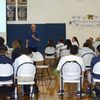
We have all heard heartbreaking stories of bullying, suicide, shootings, and gang violence involving youths. One might wonder if these tragedies could have been prevented if only someone intervened at the right moment. Are there even suitable words that can make an impactful difference?
A new way to teach students beyond the realm of traditional education has emerged with Social and Emotional Learning (SEL). Social and Emotional Learning provides a foundation for a safe and secure learning environment, and its effects can range from improving an individual’s normal day-to-day interactions to preventing potential tragedies. According to a study conducted by the University of British Columbia, the University of Illinois at Chicago, and Loyola University, its benefits continue to aid students beyond the classroom for years to come. The investigation examined grades from 82 diverse curriculums encompassing more than 97,000 students from kindergarten to middle school in the U.S., Europe and the U.K. The report not only verified that Social and Emotional Learning continued to have positive effects in the classroom, but it also confirmed that Social and Emotional learning was linked to longer-term benefits.
Through Social and Emotional Learning programs, students learn how to understand and articulate their needs and feelings without blame and judgment. They develop this vocabulary of expression utilizing strategies that develop their ability to listen empathically, form healthy relationships, and increase self-esteem. SEL programs have been shown to reduce bullying and other forms of social cruelty by increasing self-awareness, empathy, and understanding among students. SEL is especially important today considering that fact that suicide rates have increased three-fold since the 1990’s. It can even help prevent catastrophes such as school shootings.
Consider the tragedies that occurred at Columbine High School, Virginia Polytechnic Institute, Sandy Hook Elementary School, and the University of California, to name a few. In many of these disastrous incidents, the shooters’ depression, unstable home-life, and anxiety likely contributed to their acts of murder. Their need for friendship and inclusion were likely unmet, their feelings were likely not articulated, and the results of this lack of connection, support, and empathy led to devastating outcomes. These instances raise the question, would this have happened if these students had been taught how to be in a healthy relationship?
I am the founder and Executive Director of The Relationship Foundation, an organization that implements Social and Emotional Learning into schools and organizations nationwide. We ask this essential question: we spend at least twelve years in school preparing for a career; how much time do spend preparing for a relationship – any relationship? The foundation has adapted Dr. Marshall Rosenberg’s, Nonviolent Communication, a communication skillset that fosters critical thinking, empathy, and respect. We teach the fundamentals of Nonviolent Communication, empowering individuals to articulate their needs and feelings without blame and judgment, and to listen empathically. We offer instruction regarding how to create a trauma-informed school based on the CDC’s research of the Adverse Childhood Experiences. We envision a nationwide movement that establishes Social and Emotional Learning as a core component of the learning process, thus creating a climate of empathic human connection.
In a world plagued by aggression and conflict, now more than ever there is a critical need for communication skills that allow us to connect with others through greater understanding, respect, and sensitivity. Have you ever heard someone being called “needy”? In today’s society, having needs often elicits a negative association. However, day in and day out, each of us try to fulfill our needs in some way or another. You might have a need for purpose and progress. Perhaps you need acceptance and love. You could even have a need for spontaneity and creativity. These are some of the many universal needs that all people have. An initial step in the development of the Social and Emotional Learning process is acknowledging these needs in ourselves and others. It is only possessing this self-awareness that allows us to create a new level of communication where people can speak and understand each other with more respect and consideration. Social and Emotional Learning allows us to refrain from habitual thinking and prejudices and to view others with a new level of care and consideration.
Not all children are fortunate enough to grow up in stable households where they are encouraged to express their needs and feelings or where they receive nurturing, love, and attention. To the contrary, many kids are living in homes where parents themselves may not know how to effectively communicate with each other. Social and Emotional Learning may lead to a more well-rounded learning experience for both the child and the parent. SEL is being taught to teachers and parents to enhance relationships with their students and children. Much of a child’s character and self-worth is shaped by their environment – both at home and at school – and with people with whom they are continuously surrounded. We want children to be in an environment that fosters healthy and thriving relationships so they are able to feel safe and secure both at home and in school. SEL programs work best when an entire community is on board; when teachers and parents come together to do what’s best for children. SEL is character building and implements a strategy that takes both personal and academic concerns in consideration. Successful character education helps students attain the knowledge regarding what it means to be an accountable and thoughtful human being, and it helps them grow an inner-drive to put their ideal principles into play. Social and Emotional Learning is the missing piece in the contemporary American school system.
Effective communication that includes mutual respect and understanding between individuals built through Social and Emotional Learning could mean the difference between having life-long fulfilling relationships, and having to deal with the aftermath of another school shooting. Shouldn’t Social and Emotional Learning programs be included in all levels of a students’ education?
